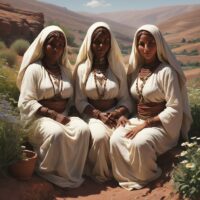Bubunna : The Fertility Spirits
Listen
At a glance
| Description | |
|---|---|
| Origin | Berber Mythology |
| Classification | Spirits |
| Family Members | N/A |
| Region | Algeria, Morocco |
| Associated With | Fertility, Agriculture |
Bubunna
Introduction
The Berber people, also referred to as the Amazigh, have inhabited North Africa for centuries, nurturing a profound mythology intertwined with their daily existence. Within their supernatural pantheon, the Bubunna occupy a significant role as benevolent female spirits linked closely with fertility and the prosperity of the land. This exploration delves into the world of the Bubunna, examining their physical characteristics, familial ties, alternative appellations, bestowed powers, and enduring impact on contemporary Berber culture.
Physical Traits
The physical appearance of the Bubunna remains elusive in available sources, consistent with their status as spiritual entities. Unlike human beings, they lack a defined physical form, often depicted as ethereal beings symbolizing fertility and agricultural abundance. Descriptions vary across Berber folklore: they may appear as youthful maidens emitting a captivating fragrance, or as elderly figures exuding wisdom and nurturing qualities. This ambiguity highlights their nature as spirits of the land, existing beyond tangible perception yet profoundly influential.
Family
In Berber mythology, the Bubunna form part of a diverse pantheon of supernatural beings. Alongside entities like the Azer-Ug-a, responsible for life creation and protection, and the Ifassen, representing natural elements such as water, wind, and fire, they inhabit the spiritual realm. Unlike some counterparts, the Bubunna lack a defined leader or familial hierarchy, functioning instead as a collective of sisterly spirits united in safeguarding the land and its inhabitants. Variations in mythologies hint at a maternal figure, known as “Ymma” or “Tamghart,” possibly symbolizing the origin of life and fertility, with the Bubunna serving as her emissaries.
Other names
While “Bubunna” serves as the predominant name for these spirits in Berber mythology, regional variations exist across different Berber communities. In Kabyle regions, they are recognized as “Tifriwin” (The Enchanted Ones) or “Theddart” (Those Who Give). In the Aurès Mountains further south, they are identified as “Tilleliyin” (The Nightly Ones), perhaps indicating a connection to nocturnal fertility rituals. These diverse appellations underscore the rich cultural diversity within Berber mythology, showcasing the reverence for the Bubunna under various names, all accentuating their vital role in sustaining life.
Powers and Abilities
The Bubunna wield their primary power in the realm of fertility, exerting influence over crop growth, livestock health, and the welfare of expectant mothers. Through prayers and rituals, Berber communities seek their blessings for abundant harvests and thriving families. Additionally, these spirits are linked with rainfall, crucial for the arid landscapes of North Africa, with legends attributing to them the ability to manipulate weather patterns, bringing vital precipitation to dry regions.
Expanding beyond their agricultural domain, the Bubunna are regarded as custodians of the natural world, dwelling within springs, rivers, and mountains, safeguarding these essential resources. Stories depict their healing abilities, utilizing natural elements like herbs and water to restore health to the infirm. Such multifaceted attributes underscore their role as beneficent entities, ensuring not only agricultural prosperity but also the holistic well-being of the Berber populace and their surroundings.
Modern Day Influence
Despite significant modernization, the belief in the Bubunna endures within Berber society. In rural areas, traditional agricultural customs incorporate offerings and rituals dedicated to these spirits, while women seeking fertility still visit revered springs and natural sites associated with the Bubunna. The tales and sayings linked to the Bubunna persist through generations, underscoring the profound bond between the Berber people and their environment.
Moreover, the Bubunna have evolved beyond their traditional roles to become symbols of Berber identity and resilience. Their connection to fertility and the natural world resonates with contemporary environmental concerns. Many Berber cultural groups and artists draw inspiration from the Bubunna, using their imagery to advocate for environmental awareness and sustainable practices. This enduring belief in the benevolent spirits reflects a profound reverence for nature and a steadfast dedication to preserving Berber cultural heritage.
Related Images
Frequently Asked Questions
What is lorem Ipsum?
I am text block. Click edit button to change this text. Lorem ipsum dolor sit amet, consectetur adipiscing elit. Ut elit tellus, luctus nec ullamcorper mattis, pulvinar dapibus leo.
What is lorem Ipsum?
I am text block. Click edit button to change this text. Lorem ipsum dolor sit amet, consectetur adipiscing elit. Ut elit tellus, luctus nec ullamcorper mattis, pulvinar dapibus leo.
What is lorem Ipsum?
I am text block. Click edit button to change this text. Lorem ipsum dolor sit amet, consectetur adipiscing elit. Ut elit tellus, luctus nec ullamcorper mattis, pulvinar dapibus leo.
What is lorem Ipsum?
I am text block. Click edit button to change this text. Lorem ipsum dolor sit amet, consectetur adipiscing elit. Ut elit tellus, luctus nec ullamcorper mattis, pulvinar dapibus leo.
What is lorem Ipsum?
I am text block. Click edit button to change this text. Lorem ipsum dolor sit amet, consectetur adipiscing elit. Ut elit tellus, luctus nec ullamcorper mattis, pulvinar dapibus leo.




